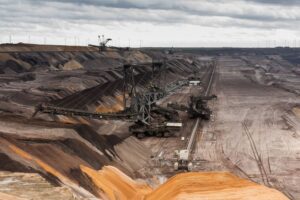Basin Energy’s Exciting New North Queensland Rare Earths Play
![]() Stuart Roberts, November 12, 2025
Stuart Roberts, November 12, 2025
There’s a reason why you should look at Basin Energy (ASX:BSN) right now. Because if you’re a uranium bull, then a man you need to follow is the Brisbane-based geologist Pete Moorhouse. That’s because he is what we call a TB92 – a Uranium True Believer – who has devoted pretty much his whole exploration career since he got out of the University of Leicester in 2005 searching for that commodity.
Consequently, there’s not much about the geological settings favouring uranium that Pete doesn’t know about. You can call him crazy (we don’t), but that kind of dedication has a habit of paying off, and it’s why we’ve been following Basin Energy, ASX: BSN, the company which Pete took public on ASX just over three years ago.
What are the Best ASX Stocks to invest in right now?
Check our buy/sell tips
Following in Red Metal’s footsteps
This article, however, isn’t just about Basin Energy and uranium. It’s also about rare earths, because the company has just acquired an exquisite piece of exploration ground in north Queensland highly prospective for both uranium and rare earths.
The new project, called Sybella-Barkly, is huge, covering a district-scale landholding of around 6,000 sq km to the south and west of Mt Isa. It’s called Sybella-Barkly because the ground sits on the cattle country of the Barkly Tableland and sits next door to the recent Sybella rare earths discovery of Red Metal (ASX:RDM). There’s an additional piece of ‘near-ology’ in the form of Paladin’s Valhalla uranium deposit. The surface sampling has been encouraging and, importantly, it’s got a number of identified paleochannels that could have dragged some of the Sybella and Valhalla mineralisation into Basin Energy’s project area.
Red Metal announced the discovery of a potential new ‘company maker’ at Sybella in August 2023. It’s a granite-hosted, near-surface rare-earths deposit just 20 kilometres southwest of Mt Isa. Red Metal calls Sybella ‘metallurgical nirvana’ because the rare earths are sitting inside soluble fluoro-carbonate minerals, and the granites don’t seem to soak up much acid, meaning that the ore can potentially be heap-leached, something it demonstrated was feasible last year.
Not only is the metallurgy great, but the deposit is also (potentially) very big. Currently there’s an inferred resource of 4.795 billion tonnes – that’s right, billions – at 302 ppm NdPr (neodymium and praseodymium) and 28 ppm DyTb (dysprosium and terbium). This is one of the largest underdeveloped light and heavy rare earths inventories in Australia, and Basin’s ground directly adjoins this system.
Scaling the Summit, again
Valhalla, 40 km northwest of Mt Isa, is a bit older than Sybella in terms of its provenance – it was discovered way back in 1954 – but it’s also big. It is Australia’s third-largest uranium resource at 148.3 million pounds of U3O8 at a grade of 728 ppm. That size is one of the reasons why Paladin paid over a billion dollars to acquire Summit Resources back in the heady days of 2007. It’s also why Paladin stands a chance to make out quite well should the Queensland Government move to lift the state’s uranium ban (in place since 2015).
However, it wasn’t the near-ology that prompted Basin to take this project, it was the fact that so much geological homework has already been done. Consider the airborne electromagnetic data. This was gathered by Summit Resources in 2007 when it owned part of Valhalla.
That programme identified numerous targets that no one ever got around to drilling. What that work identified was a stacked sequence of paleochannels within the Barkly Tablelands, fed from the Sybella Batholith. It’s a reasonable bet that some of the Sybella and Valhalla mineralisation got transported into Basin’s new ground by these paleochannels, and Basin has identified five near-surface sandstone-hosted uranium targets in this ‘roll front’ system. There’s an equal number of clay-hosted rare earths targets. And above and beyond that there’s several shears that may be hosting uranium as well.
It’s still early days for Basin at Sybella-Barkly, with the transaction only closing late last month, so the first drilling programme has yet to initiate. However, the clues at and near the surface suggest the potential for some great results into the new year. The soil and stream sediment sampling has shown up numerous rare earths anomalies, some grading in excess of 600 pp TREO, and in 2023 the project vendors did some auger drilling and came up with intersections like 5 metres at 1,951 ppm TREO and 3 metres at 705 ppm.
Uranium opportunities are showing up everywhere
Meanwhile, Basin has other projects in its portfolio with the potential to deliver, particularly as uranium has come back into favour since March 2025. In the Canadian province of Saskatchewan, for example, there’s a change to find unconformity-hosted uranium in three projects in the Athabasca Basin, where we know where the Athabasca Basin bumps against a crystalline basement but where no one has drilled to the depths where you’d potentially find the next Cigar Lake or McArthur River.
Elsewhere, Basin holds six projects in the Nordic countries of Sweden and Finland, areas where no one has seriously explored for uranium in a long time. Basin spent significant time combing through the extensive records of core and recently announced results from a re-assaying and data verification program that identified some eye-opening uranium intercepts including over 14 metres at 0.15% U3O8 from only 16 metres depth.
Swedish moratorium on uranium mining repealed
The Swedish opportunity is particularly exciting because on 5 November 2025 Sweden’s Parliament voted to repeal a moratorium on uranium mining and exploration that had been in place since 2018. The ban officially ends on 1 January 2026. That means that at the Virka, Ravaberget, Bjorkberget and Trollberget projects in northern Sweden, Basin can now go back and follow up old clues that don’t seem to be buried under too much cover, and in some cases the mineralisation is outcropping.
However, in the near term the action will be at Sybella-Barkly. Basin has now started with its own district-scale aircore drilling targeting both uranium and rare earths. In the second quarter of calendar 2026 it intends to hit rare earths target called Newmans Bore with some RC drilling. Some of this drilling will be funded by the Queensland government under its Collaborative Exploration Initiative. We think any progress made by Red Metal at its Sybella project will help buoy sentiment towards Basin, but the results from the early aircore work are what we’ll be watching out for. And that could turn Pete Moorhouse into not just a TB92 but also a TBREE. Stay tuned.
Blog Categories
Get Our Top 5 ASX Stocks for FY26
Recent Posts
Webjet Sinks 22 Percent After Softer H1 Results and Weak Domestic Demand
Webjet Falls 22 Percent After H1 Revenue Dips and Domestic Flight Demand Softens Webjet (ASX: WJL) opened down 22 percent…
Javelin Minerals Jumps 2,900 Percent on Capital Consolidation
A Sharper Share Register Sets Javelin Minerals Up for Its Next Corporate Stage Javelin Minerals (ASX: JAV) surged an extraordinary…
Why Are Droneshield Shares Dropping and Should You Be Worried
DroneShield Selloff Tests Nerves, But Fundamentals Tell a Different Story DroneShield (ASX: DRO) experienced a sharp selloff this morning that…



